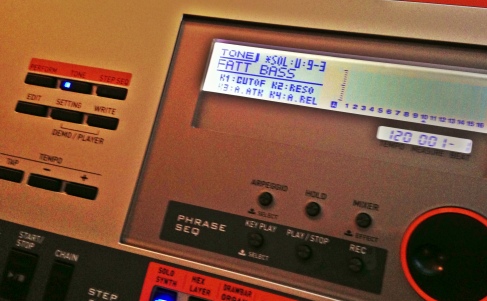XW Facebook Users Group
XW-G1 owner Scott Hamlin has created a users group over on Facebook. It is a great resource where users are sharing their experiences with the XW-P1 and XW-G1. Have a question on how to do something? You’ll get a quick answer of here. Join in at https://www.facebook.com/groups/Casio.XW.Synths/
Minimoog Inspired Set
It is so easy to be inspired by the Minimoog. Such as classic design and sound that is still sought after today. While being a digital synthesizer, the XW-series can do a pretty remarkable job of mimicking those classic Moog sounds. The Minimoog had 3 oscillators plus a noise generator and although the XW has a 4th oscillator in its Solo Synth engine – all of these sounds were crafted with the original in mind. A set of 10 Leads and basses, the specialties of the Minimoog

Go to the downloads section at Casio Music Forums to download the set of 10 presets crafted by Casio’s Mike Martin. There are separate downloads for both the XW-P1 and XW-G1.
XW-G1 Multi-Funciton Keys Explained
The XW-G1 has another trick up it’s sleeve that is unique. It is called “Multi Function keys” and it is found in Performance mode. You may have run across this feature in some of the preset Performances.  When you see the checkered box in the zone key range display, this shows that Multi-key is enabled in the top range of the keyboard. So what is Multi-key all about?
When you see the checkered box in the zone key range display, this shows that Multi-key is enabled in the top range of the keyboard. So what is Multi-key all about?
Multi-key allows you to assign events to keys, rather than just notes. With the XW-G1 this can be a Phrase, tempo change, controller changes, effects change or a switch to an entirely different Step Sequence. The possibilities here are nearly endless.
From Performance mode press edit and scroll down to find the Multi-key editor. Here you can choose what function is assigned to each key. If you use the Mult-function key to trigger a phrase, it can be assigned to any of the 16 MIDI channels, not just zones 1-4. So check out the factory performances that already use the Multi-function keys and come up with your own applications.
About the XW-G1
 In 2012 so much attention was given to the XW-P1 that the XW-G1 was a little over looked. With the XW-P1 reaching the market first and being Casio’s first synthesizer in over 20 years it’s no wonder that the XW-P1 got so much attention. While the XW-G1 was at that same NAMM show, it wasn’t much more than a prototype at that time and began shipping several months after the XW-P1. So what makes the XW-G1 unique and if you’re look at both the XW-P1 and XW-G1 which is the right one for you?
In 2012 so much attention was given to the XW-P1 that the XW-G1 was a little over looked. With the XW-P1 reaching the market first and being Casio’s first synthesizer in over 20 years it’s no wonder that the XW-P1 got so much attention. While the XW-G1 was at that same NAMM show, it wasn’t much more than a prototype at that time and began shipping several months after the XW-P1. So what makes the XW-G1 unique and if you’re look at both the XW-P1 and XW-G1 which is the right one for you?
- Sampler / Sample Loading. Probably the single most distinguishing thing about the XW-G1 is it’s sampler. The XW-G1 allows you to supplement it’s existing sound set with sampled sounds that are stored in flash memory. This means after you turn the XW-G1 off any samples you load in are still there the next time you turn it on. The XW-G1 can hold 50 user samples. It’s architecture makes it best for drum sounds but samples can also be used within the Solo Synth too.
- Solo Synth Control. The XW-G1 doesn’t have the drawbar organs and Hex Layer modes that the XW-P1 has. This means that the sliders on the left are dedicated to controlling the Solo Synth. While the XW-P1 only allows volume control over each oscillator, the XW-G1 provides access to nearly every parameter the Solo Synth has to offer. You can manipulate each oscillator individually or all at once. The capabilities for tweaking are quite remarkable. This video shows some of these capabilities:
- Sample Looper. In addition to being able to load in sampled sounds, the XW-G1 also has a sample looper. It will record what is happening live on the XW-G1 in addition to the audio inputs. The applications are remarkable. Since it syncs with the Step Sequencer it allows you to capture a groove, then dial in something else on top using the Step Sequencer and/or Solo Synth.
- Stock Drum Sounds. The XW-G1 has several drum kits that aren’t in the XW-P1 so even before you get to the sampler you have access to some aggressive electronic drums that are powerful and unique.
So which one is right for you? Both XW’s are great and they each have different strengths. The XW-P1 can do some great textured sounds with it’s Hex Layer mode, it can also do some drawbar organs which makes it well rounded as both a production and performance keyboard. If your focus however is on using the Step Sequencer, creating drum grooves and if you’re really into tweaking the monophonic Solo Synth for those ACID baselines and more the XW-G1 has the edge.
Of course if you still can’t decide, just get both.
